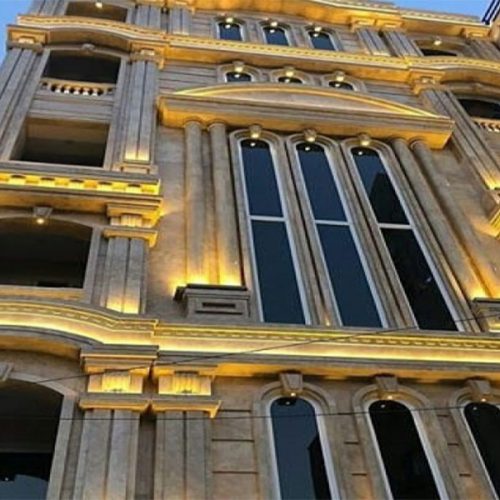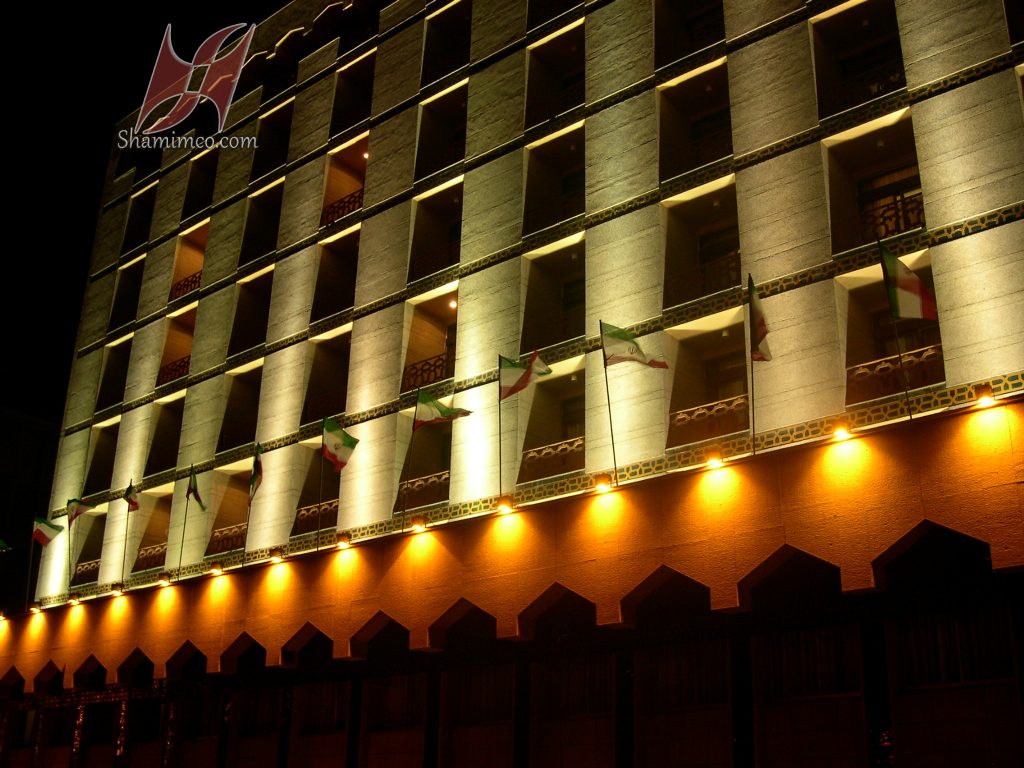Facade lighting using various techniques can greatly enhance the beauty and appeal of a building. By choosing the right light sources and properly adjusting the color and angle of the light, diverse and stunning visual effects can be created. Additionally, the use of smart lighting systems can help reduce energy consumption and improve efficiency. As a result, facade lighting not only adds a unique charm to the building but also contributes to improving the urban environment.

Types of Building Facade Lighting
Building facade lighting includes various methods and techniques, each adding a unique charm to the facade. These methods can also be combined to create a distinctive and beautiful look for your building. Below are some types of facade lighting:
- Direct Lighting: In this method, light sources are directed straight onto the facade to prominently display architectural details.
- Indirect Lighting: In this technique, light sources are directed at adjacent surfaces, and the light reflects from there onto the facade, creating a softer and more natural effect.
- Concealed Lighting: Lights are hidden behind architectural elements such as columns or frames, casting hidden and indirect light onto the facade.
- Linear Lighting: Using LED light strips installed directly or in curves on the facade to create a modern and minimalist appearance.
- Spot Lighting: Using spotlights to highlight specific details of the facade such as columns, arches, or architectural decorations.
- Colored Lighting: Employing colored lights to create diverse and attractive visual effects, especially suitable for commercial and recreational buildings.
- Dynamic Lighting: Utilizing smart lighting systems that can adjust light changes based on time and environmental conditions, giving the facade a dynamic and variable appearance.

Applications of Facade Lighting:
- Commercial Buildings: To attract attention and create a modern appearance.
- Residential Buildings: To enhance beauty and property value.
- Museums and Historical Sites: To showcase architectural details and provide protection.
- Hotels and Restaurants: To create a pleasant atmosphere and attract customers.
Principles of Building Facade Lighting
The principles of building facade lighting, utilizing various techniques, can enhance the beauty and appeal of a structure. Below are some key principles of facade lighting:
- Choosing the Right Light Sources: Use high-quality light sources, such as LEDs, which are durable and energy-efficient.
- Attention to Light Color: Select appropriate lighting colors that harmonize with the building’s materials and colors. White or warm light is usually used for facade lighting.
- Proper Light Distribution: Lighting should be designed to highlight all details and features of the building’s facade effectively. Use a combination of spot and diffused lighting.
- Creating Contrast: By using light and shadow, the facade can gain more depth and dimension. Proper contrast adds a dynamic appearance to the facade.
- Energy Efficiency: Optimize energy consumption by using modern technologies and smart systems for sustainable and eco-friendly lighting.
- Harmony with Architecture: Lighting should align with the building’s architectural design, paying special attention to natural beauty and architectural details.
- Using Various Lighting Techniques: Combine techniques such as direct, indirect, concealed, linear, spot, and colored lighting to create diverse visual effects.
- Maintenance and Repairs: Ensure the lighting system is easy to maintain and repair so that any issues can be resolved quickly.

Facade Lighting Fixtures
Facade lighting fixtures are designed to create beautiful visual effects and enhance the aesthetic appeal of buildings. Various types of facade lighting fixtures are described as follows:
Types of Facade Lighting Fixtures:
- Wall Lights: These lights are installed on the exterior walls of buildings, directing light upward, downward, or both. They are suitable for highlighting architectural details and creating attractive shadows.
- Linear Lights: These fixtures are installed as long lines and can project light onto the facade directly or indirectly. They are ideal for creating modern and minimalist effects.
- Spotlights: Spotlights focus light on specific areas of the facade, making them suitable for emphasizing key points and special details.
- Concealed Lights: These fixtures are hidden behind architectural elements or within moldings, providing indirect light to the facade and creating a soft and natural appearance.
- In-ground Lights: Installed in the ground, these lights direct light upward and are suitable for illuminating pathways, gardens, and green spaces near the building.
- Colored Lights: Lights with color-changing capabilities used for creating diverse and attractive visual effects, especially for commercial and recreational buildings.
- Solar Lights: These lights operate using solar energy, providing facade lighting without direct electricity. They are ideal for sustainable and eco-friendly projects.

Key Points in Choosing Facade Lighting Fixtures:
- Weather Resistance: Lighting fixtures for facades should withstand various weather conditions.
- Energy Consumption: Opt for energy-efficient fixtures like LEDs with high energy efficiency.
- Light Quality: Use fixtures that provide uniform and high-quality lighting without causing eye strain.
- Easy Installation: Choose fixtures with a simple and adjustable installation system.
Final Words
With proper and principled facade lighting, the beauty and visual appeal of a building at night increase significantly, creating a unique visual impression. Certainly, designing facade lighting, focusing on key structural parts, and utilizing suitable lights and elements require skilled and experienced professionals. Professional lighting is a multi-phase process that needs precise planning and proper execution. At Shamim Andisheh, this process is carried out with complete expertise and adherence to global standards. You can rely on us for the best and most professional facade lighting design and implementation. For more consultation and guidance, feel free to contact us.

 English
English العربية
العربية

















